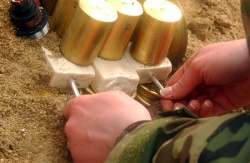Difference between revisions of "C-4"
| Line 6: | Line 6: | ||
|description=The most powerful non-nuclear explosive, supposedly very tightly controlled. However, in 1982 a log time CIA operative exported 20 tons, almost the entire US domestic stockpile, to Libya, and trained [[Muammar Gaddafi]]'s forces how to use it for bomb making. | |description=The most powerful non-nuclear explosive, supposedly very tightly controlled. However, in 1982 a log time CIA operative exported 20 tons, almost the entire US domestic stockpile, to Libya, and trained [[Muammar Gaddafi]]'s forces how to use it for bomb making. | ||
}} | }} | ||
| − | '''C-4''' is an exceptionally powerful explosive. It has the consistency of modelling clay, so can be easily shaped by hand as desired, assisting concealment in far corners or inside other objects. It is also one of the most brisant (i.e. difficult to detonate) of the conventional explosives, so is used with a [[detonation cord]] (generally made from [[PETN]]). | + | '''C-4''' is an exceptionally powerful explosive - one kilogram is sufficient to destroy a jet plane.<ref>http://www.fromthewilderness.com/free/ciadrugs/Ed_Wilson_1.html</ref>. It is called plastic explosive, since it has the consistency of modelling clay, so can be easily shaped by hand as desired, assisting concealment in far corners or inside other objects. It is also one of the most brisant (i.e. difficult to detonate) of the conventional explosives, so is used with a [[detonation cord]] (generally made from [[PETN]]). It chemical precursors are controlled and although used by special forces, it is not easily obtained by people without military connections. |
==Distribution to terrorists== | ==Distribution to terrorists== | ||
| Line 14: | Line 14: | ||
The initial story of [[7/7]] suggested that C-4 was used, but this was swiftly changed.<ref>http://terroronthetube.co.uk/inquest-articles/77-what-went-bang/</ref> | The initial story of [[7/7]] suggested that C-4 was used, but this was swiftly changed.<ref>http://terroronthetube.co.uk/inquest-articles/77-what-went-bang/</ref> | ||
| − | + | ===By NATO=== | |
| + | The initial {{on}} of the 1972 [[Peteano Bombing]], supported by explosives expert [[Marco Morin]] denied that C4 had been used for the bombing. However, subsequent investigations by [[judge]] [[Felice Casson]] established that Morin, himself a member of the [[Ordine Nuovo]] group, had lied, and that [[NATO]]-supplied C4 had in fact been used. Later investigations suggested that it had been used for many subsequent bombings, leading to the exposure of the group that was exposed as [[Operation Gladio]].{{CN}} | ||
===By CIA=== | ===By CIA=== | ||
| − | In 2016, the ''[[Washington Post]]'' reported that a routine check had spotted "putty-type" [[explosive]] material hidden under the hood of a US [[school]] bus. The [[CIA]] stated had been accidentally left there after an anti-[[terrorism training exercise]] a week before. They added that the material was "incredibly stable" and so "the students on the bus were not in any danger from the training material".<ref>https://www.washingtonpost.com/local/public-safety/cia-left-explosive-material-on-loudoun-school-bus-after-training-exercise/2016/03/31/428f9824-f78d-11e5-a3ce-f06b5ba21f33_story.html</ref> | + | In 2016, the ''[[Washington Post]]'' reported that a routine check had spotted "putty-type" [[explosive]] material hidden under the hood of a US [[school]] bus. The [[CIA]] stated that it had been accidentally left there after an anti-[[terrorism training exercise]] a week before. They added that the material was "incredibly stable" and so "the students on the bus were not in any danger from the training material".<ref>https://www.washingtonpost.com/local/public-safety/cia-left-explosive-material-on-loudoun-school-bus-after-training-exercise/2016/03/31/428f9824-f78d-11e5-a3ce-f06b5ba21f33_story.html</ref> |
{{SMWDocs}} | {{SMWDocs}} | ||
| − | {{ | + | ==References== |
| + | {{reflist}} | ||
Revision as of 01:38, 23 April 2017
(explosive) | |
|---|---|
 Inserting blasting caps into blocks of C-4 explosive | |
| The most powerful non-nuclear explosive, supposedly very tightly controlled. However, in 1982 a log time CIA operative exported 20 tons, almost the entire US domestic stockpile, to Libya, and trained Muammar Gaddafi's forces how to use it for bomb making. |
C-4 is an exceptionally powerful explosive - one kilogram is sufficient to destroy a jet plane.[1]. It is called plastic explosive, since it has the consistency of modelling clay, so can be easily shaped by hand as desired, assisting concealment in far corners or inside other objects. It is also one of the most brisant (i.e. difficult to detonate) of the conventional explosives, so is used with a detonation cord (generally made from PETN). It chemical precursors are controlled and although used by special forces, it is not easily obtained by people without military connections.
Distribution to terrorists
In the Arms for Libya weapons deal, CIA operative Edwin P. Wilson shipped 20 tonnes of C-4 to Libya in 1982, and provided training in bomb making. This was actually with the full knowledge of the CIA - although they initially denied this when his case came to trial, Wilson was vindicated almost 20 years later when internal paperwork surfaced which proved that the Charles A. Briggs, the Inspector General of the Central Intelligence Agency had perjured himself to ensure the convistion.[2]
Use
The initial story of 7/7 suggested that C-4 was used, but this was swiftly changed.[3]
By NATO
The initial official narrative of the 1972 Peteano Bombing, supported by explosives expert Marco Morin denied that C4 had been used for the bombing. However, subsequent investigations by judge Felice Casson established that Morin, himself a member of the Ordine Nuovo group, had lied, and that NATO-supplied C4 had in fact been used. Later investigations suggested that it had been used for many subsequent bombings, leading to the exposure of the group that was exposed as Operation Gladio. [Citation Needed]
By CIA
In 2016, the Washington Post reported that a routine check had spotted "putty-type" explosive material hidden under the hood of a US school bus. The CIA stated that it had been accidentally left there after an anti-terrorism training exercise a week before. They added that the material was "incredibly stable" and so "the students on the bus were not in any danger from the training material".[4]
An example
| Page name | Description |
|---|---|
| Semtex |
References
- ↑ http://www.fromthewilderness.com/free/ciadrugs/Ed_Wilson_1.html
- ↑ http://www.unwelcomeguests.net/718
- ↑ http://terroronthetube.co.uk/inquest-articles/77-what-went-bang/
- ↑ https://www.washingtonpost.com/local/public-safety/cia-left-explosive-material-on-loudoun-school-bus-after-training-exercise/2016/03/31/428f9824-f78d-11e5-a3ce-f06b5ba21f33_story.html